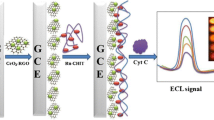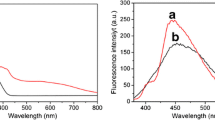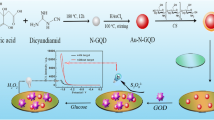Abstract
A novel internal standard electrochemiluminescence (ECL) sensor has been designed for the detection of ascorbic acid (AA). The adopted dual-emission luminophore (NSGQDs-PEI-luminol-Pt) is composed of nitrogen and sulfur double-doped graphene quantum dots (NSGQDs, as the main luminophore), luminol (as the auxiliary luminophore and internal standard), platinum nanoparticles (Pt NPs, as the co-reaction accelerator), and polyetherimide (PEI, as the linker of NSGQDs and luminol). The results suggest obviously enhanced ECL intensities by the Förster resonance energy transfer (FRET) between luminol (donor) and NSGQDs (acceptor). In this sensing system, the cathodic ECL intensities of NSGQDs (ECL-1, −1.8 V vs. Ag/AgCl) gradually decrease with increasing concentration of AA, while the anodic ECL intensities of luminol (ECL-2, 0.3 V vs. Ag/AgCl) almost remain essentially constant at a potential window from −2.0 to 0.4 V. The natural logarithm of the ratio between ECL-1 and ECL-2 (ln I (ECL-1/ECL-2)) shows a good linear relationship with AA concentration ranging from 10 to 360 nM. The regression equation is ln I (ECL-1/ECL-2) = − 0.0059 cAA + 3.55 (R2 = 0.992) with a limit of detection of 3.3 nM. Such sensor has also been applied for monitoring AA in human serum. The recovery range was 96.5–105.3% and the relative standard deviation was 1.3–3.3%.
Graphical abstract







Similar content being viewed by others
References
Valenti G, Zangheri M, Sansaloni SE, Mirasoli M, Penicaud A, Roda A, Paolucci F (2015) Transparent carbon nanotube network for efficient electrochemiluminescence devices. Chem Eur J 21:12640–12645
Rubinstein I, Bard AJ (1981) Electrogenerated chemiluminescence. 37. Aqueous ecl systems based on tris(2,2′-bipyridine)ruthenium(2+) and oxalate or organic acids. J Am Chem Soc 103:512–516
Liu JL, Zhao M, Zhuo Y, Chai YQ, Yuan R (2017) Highly efficient intramolecular electrochemiluminescence energy transfer for ultrasensitive bioanalysis of aflatoxin m1. Chem Eur J 23:1853–1859
Chen Y, Zhou S, Li L, Zhu JJ (2017) Nanomaterials-based sensitive electrochemiluminescence biosensing. Nano Today 12:98–115
Tetsuka H, Asahi R, Nagoya A, Okamoto K, Tajima I, Ohta R, Okamoto A (2012) Optically tunable amino-functionalized graphene quantum dots. J Adv Mater 24:5333–5338
Sun HJ, Gao N, Wu L, Ren JS, Wei WL, Qu XG (2013) Highly photoluminescent amino-functionalized graphene quantum dots used for sensing copper ions. Chem Eur J 19:13362–13368
Du Y, Guo SJ (2016) Chemically doped fluorescent carbon and graphene quantum dots for bioimaging, sensor, catalytic and photoelectronic applications. Nanoscale 8:2532–2543
Li S, Li Y, Cao J, Zhu J, Fan L, Li X (2014) Sulfur-doped graphene quantum dots as a novel fluorescent probe for highly selective and sensitive detection of Fe3+. Anal Chem 86:10201–10207
Riaz R, Ali M, Sahito IA, Arbab AA, Maiyalagan T, Anjum AS, Ko MJ, Jeong SH (2019) Self-assembled nitrogen-doped graphene quantum dots (N-GQDs) over graphene sheets for superb electro-photocatalytic activity. Appl Surf Sci 480:1035–1046
Chen HM, Zhang H, Yuan R, Chen SH (2017) Novel double-potential electrochemiluminescence ratiometric strategy in enzyme-based inhibition biosensing for sensitive detection of organophosphorus pesticides. Anal Chem 89:2823–2829
Zhang HR, Xu JJ, Chen HY (2013) Electrochemiluminescence ratiometry: a new approach to DNA biosensing. Anal Chem 85:5321–5325
Wang Y, Zhang Y, Sha H, Xiong X, Jia N (2019) Design and biosensing of ratiometric electrochemiluminescence resonance energy transfer aptasensor between g-C3N4 nanosheet and Ru@MOF for amyloid-β protein. ACS Appl Mater Inter 11:36299–36306
Lin Y, Wang J, Luo F, Guo LH, Qiu B, Lin ZY (2018) Highly reproducible ratiometric aptasensor based on the ratio of amplified electrochemiluminescence signal and stable internal reference electrochemical signal. Electrochim Acta 283:798–805
Boysen A K, Heal K R, Carlson L T, Ingalls A E (2017) Best-matched internal standard normalization in liquid chromatography-mass spectrometry metabolomics applied to environmental samples. Anal Chem 1363–1369
Gong Q, Qin W, Xiao P, Wu X, Li L, Zhang G, Zhang R, Sun J, Yao SQ, Huang W (2020) Internal standard fluorogenic probe based on vibration-induced emission for visualizing PTP1B in living cells. Chem Commun 56:58–61
Shuang L, Xiang L, Yuan LL, Hai YZ, Wu LH, Li W (2018) Self-assembly of Au@Ag core-shell nanocubes embedded with internal standard for reliable quantitative SERS measurements. Anal Methods-UK 10:4201–4208
Dong YX, Cao JT, Wang B, Ma SH, Liu YM (2018) Spatial-resolved photoelectrochemical biosensing array based on a CdS@g-C3N4 heterojunction: a universal immunosensing platform for accurate detection. ACS Appl Mater Inter 10:3723–3731
Organization W H (1970) Requirements of ascorbic acid, vitamin D, vitamin B 12, folate, and iron: report of a joint FAO/WHO expert group. WHO
Bottegal M, Lang L, Miller M, McCord B (2010) Analysis of ascorbic acid based black powder substitutes by high-performance liquid chromatography/electrospray ionization quadrupole time-of-flight mass spectrometry. Rapid Commun Mass Spectrom 24:1377–1386
Zare HR, Nasirizadeh N (2011) A comparison of the electrochemical and electroanalytical behavior of ascorbic acid, dopamine and uric acid at bare, activated and multi-wall carbon nanotubes modified glassy carbon electrodes. J Iran Chem Soc 8:S55–S66
Li XJ, Sun X, Fan DW, Yan T, Feng R, Wang H, Wu D, Wei Q (2019) A ternary quenching electrochemiluminescence insulin immunosensor based on Mn2+ released from MnO2@Carbon core-shell nanospheres with ascorbic acid quenching AuPdPt-MoS2@TiO2 enhanced luminol. Biosens Bioelectron 142:111551
Zhang RZ, Adsetts JR, Nie YT, Sun XH, Ding ZF (2018) Electrochemiluminescence of nitrogen- and sulfur-doped graphene quantum dots. Carbon 129:45–53
Cao J, Zhang H, Liu X, Zhou N, Yang D (2019) Plasmon-coupled förster resonance energy transfer between silicon quantum dots. J Phys Chem C 123:23604–23609
Cui H, Zou GZ, Lin XQ (2003) Electrochemiluminescence of luminol in alkaline solution at a paraffin-impregnated graphite electrode. Anal Chem 75:324–331
Habibi B, Pournaghi-Azar MH (2010) Simultaneous determination of ascorbic acid, dopamine and uric acid by use of a MWCNT modified carbon-ceramic electrode and differential pulse voltammetry. Electrochim Acta 55:5492–5498
Ma Q, Li Y, Lin ZH, Tang G, Su XG (2013) A novel ascorbic acid sensor based on the Fe3+/Fe2+ modulated photoluminescence of CdTe quantum dots@SiO2 nanobeads. Nanoscale 5:9726–9731
Rong M, Lin L, Song X, Wang Y, Zhong Y, Yan J, Feng Y, Zeng X, Chen X (2015) Fluorescence sensing of chromium (VI) and ascorbic acid using graphitic carbon nitride nanosheets as a fluorescent “switch”. Biosens Bioelectron 68:210–217
Zhang Y, Fang X, Zhao H, Li Z (2018) A highly sensitive and selective detection of Cr (VI) and ascorbic acid based on nitrogen-doped carbon dots. Talanta 181:318–325
Wang YN, Wang SD, Yang LL, Zhao YF, Yang QF (2020) A luminescent cadmium coordination polymer for highly sensitive detection of ascorbic acid. J Solid State Chem 289:121519
Liu YH, Wei ZN, Duan WX, Ren CL, Jiang D (2018) A dual-mode sensor for colorimetric and “turn-on” fluorescent detection of ascorbic acid. Dyes Pigments 149:491–497
Chen H, Li W, Zhao P, Nie Z, Yao S (2015) A CdTe/CdS quantum dots amplified graphene quantum dots anodic electrochemiluminescence platform and the application for ascorbic acid detection in fruits. Electrochim Acta 178:407–413
Funding
This work was supported by the National Natural Science Foundation of China (22077105) and Natural Science Foundation Project of CQ CSTC (cstc2020jcyj-msxmX0854), China.
Author information
Authors and Affiliations
Corresponding author
Ethics declarations
Conflict of interest
The authors declare that they have no competing interests.
Additional information
Publisher’s note
Springer Nature remains neutral with regard to jurisdictional claims in published maps and institutional affiliations.
Supplementary information
ESM 1
(DOCX 916 kb)
Rights and permissions
About this article
Cite this article
Liu, P., Meng, H., Han, Q. et al. Determination of ascorbic acid using electrochemiluminescence sensor based on nitrogen and sulfur doping graphene quantum dots with luminol as internal standard. Microchim Acta 188, 120 (2021). https://doi.org/10.1007/s00604-021-04761-w
Received:
Accepted:
Published:
DOI: https://doi.org/10.1007/s00604-021-04761-w




